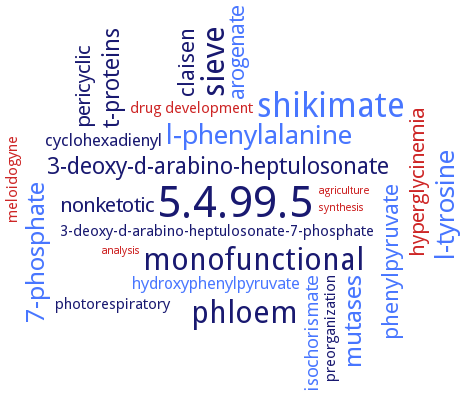Please wait a moment until all data is loaded. This message will disappear when all data is loaded.
Please wait a moment until the data is sorted. This message will disappear when the data is sorted.
*MtCM prepared from Escherichia coli strain KA29
AtCM1, sequence comparisons, recombinant expression of N-terminally His6-tagged wild-type and mutant enzymes in Escherichia coli strain Rosetta II (DE3)
AtCM3, sequence comparisons, recombinant expression of N-terminally His6-tagged wild-type and mutant enzymes in Escherichia coli strain Rosetta II (DE3)
Construction of mycobacterial reporter plasmids is described. In contrast to the studies in Mycobacterium tuberculosis, very little is known of CMs in Mycobacterium smegmatis. Homolouges of Rv1885c and Rv0948c are present in the MSMEG5513 have been recently annotated as potential CMs. Rv1885c protein used as a control for the experiments describing Rv0948c and the two Mycobacterium smegmatis homologues
Escherichia coli strain KA29
Escherichia coli strains C600lambda lysogen, MZ1, Nova Blue, BL21(DE3)
expressed in Arabidopsis thaliana
-
expressed in Escherichia coli
-
expressed in Escherichia coli BL21(DE3) cells
expressed in Escherichia coli KA13 cells
-
expressed in Escherichia coli strain BL21
expressed in Escherichia coli strain FA114
-
expressed in Escherichia coli strain KA13
expression in a chorismate mutase deficient Escherichia coli mutant
-
expression in a Saccharomyces cerevisiae aro7DELTA strain
expression in Escherichia coli
expression in Escherichia coli BL21
-
expression in Escherichia coli BL21 (DE3)
-
expression in Escherichia coli BL21(DE3)
expression in Escherichia coli with a His-tag
gene Bphy_7813, recombinant expression of His-tagged enzyme in Escherichia coli strain BL21(DE3)-R3 Rosetta
gene BTH_I1596, recombinant expression of His-tagged enzyme in Escherichia coli strain BL21(DE3)R3 Rosetta
gene Tparo7, DNA and amino acid sequence determination and analysis, quantitative real-time PCR enzyme expression analysis
generation of transgenic Arabidopsis plants expressing a bacterial feedback-insensitive chorismate mutase/prephenate dehydratase gene (truncated PheA) under the control of the 35S CaMV promoter, fused inframe at the 3' end of the coding sequence to DNA encoding a hemagglutinin epitope tag. Two chimeric constructs: in one, DNA encoding a Rubisco small subunit-3A plastid transit peptide is fused in-frame to the 5' end of the PheA open reading frame to direct the bacterial enzyme in to the plastid where aromatic amino acid biosynthesis is localized. The second construct lacks the Rubisco small subunit-3A plastid transit peptide in order to test whether aromatic amino acid metabolism is strictly localized to the plastid or whether at least some parts of it operate in the cytosol. Both constructs transformed into Arabidopsis plants, and homozygous T2 plants are generated
-
in Mycobacterium smegmatis: homologues of each CM from Mycobacterium tuberculosis are found in Mycobacterium smegmatis, a nonpathogenic species. These homologues (which correspond to ORFs MSMEG5513 and MSMEG2114 respectively) cloned, expressed in Escherichia coli (strains DH5alpha, DH10B and BL21(DE3)), and demonstrate to possess CM activity as their Mycobacterium tuberculosis counterparts
overexpressed in Escherichia coli
overexpressed in Escherichia coli BL21 (DE3). Mycobacterium tuberculosis CMs are believed to have evolved from duplication of an ancestral CM gene, formation of the active site in a single polypeptide chain appears to be a consequence of this duplication event
-
overexpression in a Saccharomyces cerevisiae aro7DELTA mutant strain
Q9Y7B2
overexpression in Escherichia coli
overexpression in Hansenula polymorpha
recombinant expression of enzyme BsCM in Escherichia coli strain KA13
recombinant expression of His-tagged enzyme in Escherichia coli strain BL21(DE3), subcloning in Escherichia coli strain DH5alpha
recombinant His6-tagged wild-type enzyme from Escherichia coli strain Rosetta II (DE3) by nickel affinity chromatography, tag cleavage with thrombin, dialysis, benzamidine/nickel affinity chromatography, and gel filtration
sequence comparisons, recombinant expression of codon-optimized N-terminally His6-tagged enzyme in Escherichia coli strain Rosetta II (DE3)
the Rv1885c gene product is synthesized with an N-terminal signal sequence of 33 amino acids, which is cleaved off upon heterologous expression in Escherichia coli, and transported into the periplasmic space
-

-
expressed in Escherichia coli BL21(DE3) cells

-
expressed in Escherichia coli BL21(DE3) cells
expressed in Escherichia coli BL21(DE3) cells
expressed in Escherichia coli BL21(DE3) cells
expressed in Escherichia coli strain KA13

-
expressed in Escherichia coli strain KA13
expressed in Escherichia coli strain KA13
-
expression in Escherichia coli

-
expression in Escherichia coli
-
expression in Escherichia coli
-
expression in Escherichia coli
-
expression in Escherichia coli
-
expression in Escherichia coli
expression in Escherichia coli
overexpression in Escherichia coli

-
overexpression in Escherichia coli
sequence comparisons, recombinant expression of codon-optimized N-terminally His6-tagged enzyme in Escherichia coli strain Rosetta II (DE3)

sequence comparisons, recombinant expression of codon-optimized N-terminally His6-tagged enzyme in Escherichia coli strain Rosetta II (DE3)
sequence comparisons, recombinant expression of codon-optimized N-terminally His6-tagged enzyme in Escherichia coli strain Rosetta II (DE3)




 results (
results ( results (
results ( top
top





